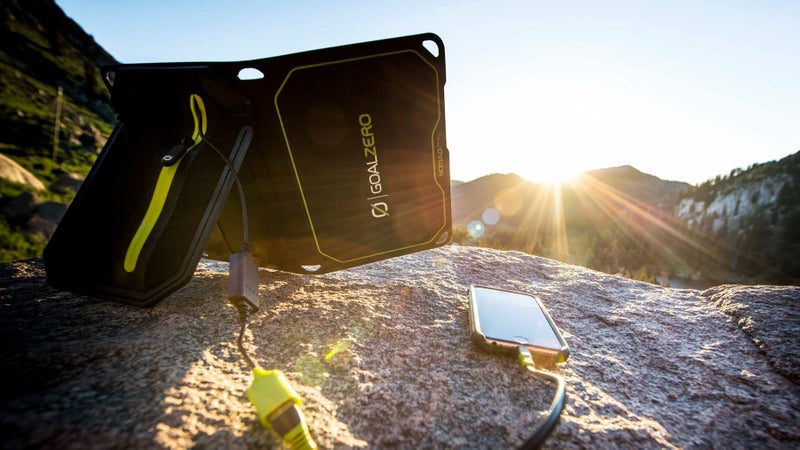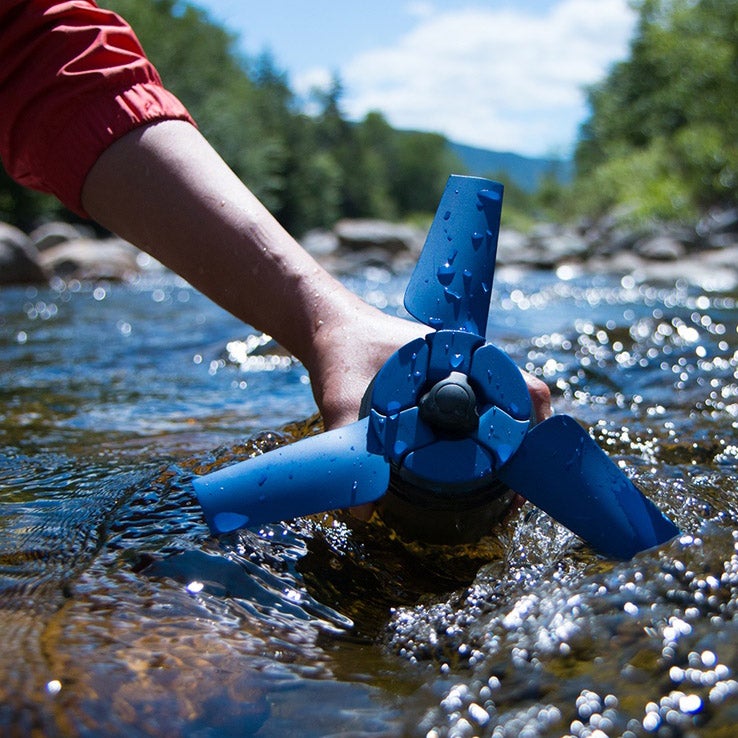A few days ago,��my friend Lee posted a story about the����to my Facebook wall, asking if he should buy one. My answer? A swear word I can’t print here, followed by an unequivocal,��“No.”
The small turbine is designed to be dropped into a flowing stream��or towed behind a boat. The force of moving water spins its blades, generating enough electricity to charge its small battery pack, which you can then use to top up your phone, light your campsite, or recharge a Bluetooth speaker. On its��Kickstarter��page, the Estream’s designers say it’s��“the most powerful portable green energy available to backpackers and hikers.” And it was successfully funded, with 681 backers pledging $147,863 of its $80,000 goal.��
Electricity from flowing water? Neat, right?
Not so fast.��
For any outdoor activity where you need to bring a little extra power with you, without a vehicle, batteries and battery packs are a superior option to solar panels, stoves, or any other power generator that��runs on sun,��fire, wind, or water.��Batteries are cheaper, lighter, more versatile, and they'll last longer.��Take the Estream. Given optimal conditions, the Estream is capable of charging its 6,400 mAh battery in 4.5 hours. The device weighs 1.8 pounds and will retail for $250. Compare that to a simple portable battery pack like the . It, too, has a 6,000 mAh capacity, but weighs just 8.96 ounces. That’s enough to charge an iPhone 7’s battery from��empty��to��full��three times. When was the last time you needed to fully charge your phone more than three times during a camping trip? And, if for some reason Tinder really is eating through your battery that fast while you’re in the middle of the woods, you could carry three of those battery packs for the same weight penalty as a single��Estream, while still saving yourself $100. No flowing water necessary.��
https://www.youtube.com/embed/5Ktui4bEElk
The same math applies no matter the power source. Any generator small and light enough for a human to carry with them into the backcountry is currently far, far outmatched on price, weight, and even outright charging capacity by cheap, small, light, and commonly available batteries.��
So what’s the appeal? The ability to generate your own power in the field is a relatively new development,��and that novelty combined with the innate appeal of green energy sources is enough to capture the hearts and minds of outdoorsy types like you and me.��
I ran all this past my friend Tom Pine,��an energy engineer,��who was quick to opine about the issues these products face. “You have to have optimal conditions for a portable generator to work as advertised,” he explained. “Take solar panels for instance. The energy outputs you see quoted are for very bright sunshine, typically 1,000 watts per square��meter. That’s Burning Man conditions, so your real-world-panel output will be less.”
Solar panels need very bright, mid-day sunshine to perform as advertised. Panel orientation, shade, clouds, and how high or low the sun is in the sky given the time of day and the time of year are all variables. Will the sun be shining when you need to charge something? Do you have time to mind the orientation of the panels throughout the day, tracking the path of the sun across the sky? Are you camping or hiking somewhere with an uninterrupted view of the sky, during a time of year when the weather is clear, days are long, and the sun is high in the sky? If you plan to leave the panels unattended while you go do fun stuff, will you return to the same location later in the day? Even if the answer to all those questions is,��“Yes,” a portable battery pack will still charge your gadgets faster, for a smaller��weight and cost penalty.��

Don’t get me wrong, I get the appeal. A couple of years ago, when the BioLite CampStove first came out, I was excited to test it, and . It houses a thermoelectric generator that you power by burning wood in the stove, supposedly allowing you to cook��and charge your gadgets at the same time. In practice, maintaining a tiny fire in a tin can using twigs is incredibly laborious, requiring you to constantly remove whatever you’re trying to cook from the top to add more twigs��or empty excess ash. All while trying to not spill stuff on��or burn the phone that’s tethered to the thing via a USB cord. Charging itself proved to take much longer than advertised. While BioLite claims a continuous USB power output of two watts, you have to have your tiny fire-in-a-can absolutely raging to achieve any electricity output at all (I averaged about a third of my cooking/fire time with the ability to charge), and even then that was only enough to maintain a constant battery level while playing music on a Bluetooth speaker. The phone didn’t actually charge at all.��
I now carry a much better stove, along with a 10,000 mAh battery pack, for much less weight, at much lower cost. And that battery pack will charge both my phone and speaker simultaneously.��
What about long-term power needs? And the ability to charge things beyond simply a phone or speaker? Well,��one of our contributors, Chris Brinlee Jr, needed to take his DSLR��and Microsoft Surface Pro tablet along on a 23-day trek through the Himalayas last year, shooting, editing, and backing up photos and videos along the way. He�� to handle all that. It weighs five pounds��and costs $550, but brings with it the ability to charge higher-capacity devices like laptops and camera batteries. How’d it perform? Even strapped to the outside of his pack, hiking at high elevations above the treeline, he couldn’t get the panels to charge the battery pack to 100 percent capacity in a single day. Even stationary, with the ability to keep the panels optimally oriented, a full day’s charge was only enough power to top up five camera batteries, a GPS navigator, and a Delorme Inreach Explorer. That was the peak of the setup's charging performance, it never again managed as much. And even that was well below its advertised capacity.��
Chris’ solution? He’s now ditched the Goal Zero in favor of carrying more camera batteries��and a battery pack for his other devices. Doing so is lighter, cheaper, and allows him the flexibility to charge all that stuff when needed, not only during days sitting stationary under the high altitude sun.
It should be noted that vehicle-portable solar panels, and the big, heavy, high-capacity batteries that go with them do make an excellent long-term, off-grid power solution. But you're not carrying something that weighs on your back.��
To determine if a portable power generator��of any kind—solar, fire, water, wind, cold fusion—is right for you, simply determine how much power your��gadget needs��in a given time period, then compare the cost of the generator to the��price of a battery,��which can likely��meet your needs for less money, weight, and hassle.��Bear in mind that larger devices like laptops require higher output charging than most little battery packs provide. But if we're starting to talk about charging laptops in the backcountry, we're starting to move beyond the idea of man-portable power.

Let’s look at my needs, for instance. I typically carry my phone (a Google Nexus 5X with a 2,700 mAh battery), an , and a . With the phone in airplane mode, the whole kit can easily last a weekend of occasionally music playing��and constant picture taking, without additional charging. If I want to use the phone as a GPS navigator, I will need to top it up at least once, but it’s nice to have a little extra juice, just in case. I’d imagine that’s a typical, if not generous,��gadget load for most people, doing most things outdoors. The solar panel kit that would make sense for my use would be the . It costs $170, weighs 1.56 pounds, and its battery pack can hold 7,800 mAh. Recharging that pack takes a full day of optimal sun exposure. So I’d get three full phone charges off that, without employing the panels, or more realistically, a few partial charges, and maybe some extra juice for my speaker or camera. And, if I needed more, I’d need to leave everything sitting out in the sun for a day.��
In reality, I carry an , which has thus far provided more capacity than I’ve ever needed to use on a single trip. It weighs just 10.8 ounces. I could carry a second one, save $10 and a few ounces over the solar setup, and charge my phone fully almost eight times. And do that wherever��and whenever I wanted, regardless of the time of day, time of year, or even the weather. I usually plug my stuff in at night, while I’m sleeping inside my tent.��
“Think of it in ounces-per-charge,” says Pine. “That 10,000 mAh pack gives Wes 3.7 charges, so it's providing one charge for roughly three ounces. How many charges do you realistically need to perform on a given outing, and what's the lightest way to get them?”
As it stands, human-portable power generation requires too-specific��circumstances (a full day of sun, flowing water, constant fire stoking), and offers too little power to make any sense for people doing active stuff outdoors. Particularly when portable battery packs are so cheap, so ubiquitously available, don’t peg you to a specific location, and don't��require specific circumstances to function. The promise of clean, off-grid energy? It’s just not��truly portable yet, at least if you want to carry it yourself.��


